Occupation at the acropolis dates back to prehistoric times. A Mycenaean palace sat here in the Late Bronze Age and it served as a political and religious center in the Archaic period. The acropolis was dedicated to religious functions only in Classical times. Following the Classical period, this area was always a key military position, the first part of the city taken during invasions (e.g., by the Franks, Venetians, Turks, Bavarians).
Athens Acropolis
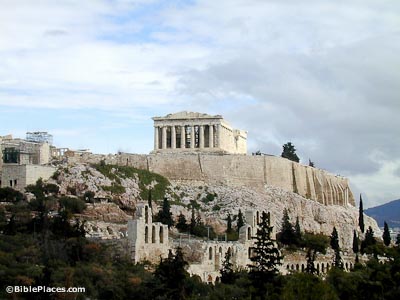
Acropolis
Acropolis at Night
The acropolis is crowned by the Parthenon, completed in 432 BC. Other structures built on the acropolis in the Classical period include a monument to Agrippa, the propylaia, the temple of Athena Nike, an older temple of Athena, and the Erechtheion.
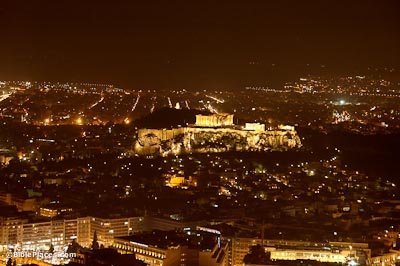
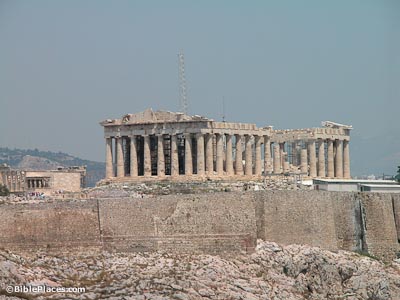
The Parthenon
The Parthenon (“House of the Maid”) is the grandest but not most important structure on the acropolis, ritually speaking. The Parthenon was much larger than most other Doric temples and had several sculptures, including Athena’s birth (east pediment), a contest between Athena and Poseidon (west pediment), the Trojan War (north side), and battles between Lapiths and Centaurs (south side) and Amazons and Greeks (west end).
The Parthenon
The Parthenon held silver, gold, and ivory treasures when it was constructed. Later, in the 6th century AD, it was used as a church. The Franks turned it into a cathedral in the 13th century. Because it served as storage for Turkish ammunition, the Venetians blew it up in 1687. The Parthenon was restored in 1834–44 and again since 1983.
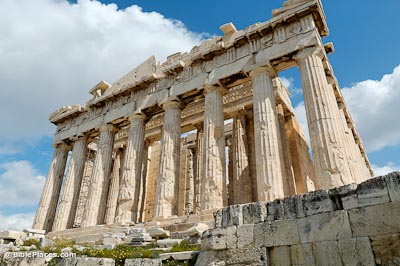
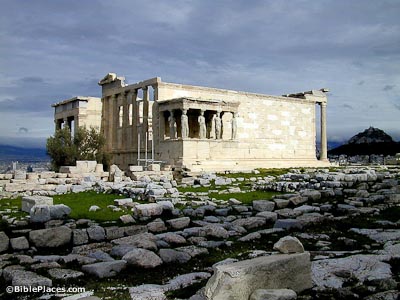
The Erechtheion
The Erechtheion was built to honor the founder of the city and included the sanctuary of Erechtheus and the temple of Athena Polias. Both Erechtheus and Poseidon were worshiped in this temple. The Porch of the Karyatids is the most famous part of the structure, where statues of maidens were used as columns. Their right hands (today missing) once held libation bowls for drink offerings.

Download all of our Greece photos!
$34.00 $49.99 FREE SHIPPING
Related Websites
See also Athens. For a Bible chapter related to the city of Athens, see Acts 17.
Acropolis (World History Encyclopedia) A good introductory article to the site’s history and features. This website also has pages focusing specifically on the Parthenon (including a 3D colorful model) and the Erechtheion.
Acropolis (History) This article is especially helpful for an overview of the Acropolis’s more modern history.
The Athenian Acropolis (Bible History Daily) This article is quite comprehensive, and includes a nice selection of images.
The Acropolis of Athens (Athensguide.com) A page with good site descriptions and even better photos.
The Acropolis (Visit Greece) The information on this page is substantial, and it also links to helpful pages dedicated to specific structures on the Acropolis.
A Historical Account of the Acropolis (Athens Guide) A detailed account of the site’s history with a helpful map.
The Acropolis of Athens (Archaeology Magazine) A brief discussion of modern restoration efforts.
The First Photograph of the Acropolis and Its History (Greek News Agenda) Features three 1842 images of the Acropolis, along with some fascinating history.
A Day in the Life of an Ancient Greek Architect (YouTube) This 5-minute video gives an entertaining look at the construction of the Parthenon.
The Parthenon is Blown Up (History Today) This article discusses the explosion of the Parthenon on September 26, 1687.
The Erechtheion: Iconic Temple of Myth and Splendor (History Tools) This website discusses the history of this particular building at some length.
See Athens Through the Eyes of a World War II Historian (History Net) This article gives a more modern look at some history surrounding the Acropolis and Athens in the mid-1900s; one highlight is a photo of the Nazi German flag being hoisted on the Acropolis.